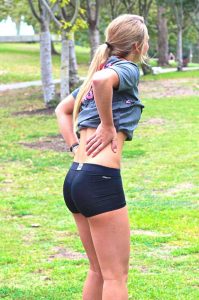Low Back Pain
On a daily basis, most chiropractors will agree that 80% of their patients complain of low back pain, if not more. As most patients with low back pain know, core and glute strength are the major contributors to this chronic condition. Anatomically speaking the main muscles of the low back include:
- Erector spinae
- Longissimus thoracis
- Ilocostalis lumborum
- Multifidus
- Quadratus Lumborum
- Intertransversarii
- Interspinales.
Other supportive muscles of the low back and core can include:
- Latisimus Dorsi
- Serratus Posterior
- External & Internal Oblique
The main function of muscle group for the low back is flexion (80-90 degrees), extension (30 degrees), lateral flexion (20 degrees), and slight rotation (45 degrees). Like with any other overuse injury, once the main spine stabilizers have been injured the body will start to compensate the biomechanics of the lumbar spine with other muscle groups. The lumbar spine is a joint of stability, but will take on the role of mobility if the hips and thoracic spine are not moving properly. Those who suffer from extension-based back pain will have short hip flexors, poor glute function, and a lack of anterior core stability- leading to an anterior pelvic tilt.
The anterior pelvic tilt produced can increase low back pain and puts increased stress on the anterior joint line of the knee and puts the hamstring in a position of constant stretch, leaving it susceptible to strains. Those who suffer from flexion-based motion have more pain in sitting, as they tend to have flatter backs and increased stress on the posterior ligaments of the spine. Flexion-based pain is the classic symptomatic disc pain patient, with or without radicular pain into the legs.
Other symptoms associated with low back pain can include:
- Pain radiating into the glutes and thighs
- Decreased range of motion
- Weakness in the core and glutes
- Discomfort with sleep and lifting objects
- Stenosis of the spine
- Disc herniation
- Vertebral fracture or slippage
Muscle weakness of the core and glutes are the primary source of chronic low back pain in addition to abnormal motion of the hips and thoracic spine. Many spine problems are the result of years and years of cumulative trauma, with repeated flexion/extension, lateral flexion, and rotation. It is likely that a lot of that trauma took place before an active life style and the low back could not handle the stress load. Some patients may present will decreased range of motion and no pain at all, while others may have increased range of motion and also be in a great deal of pain. This is because the lumbar spine functions better with less motion.
To rule out other conditions that may be causing the chronic low back pain the first source of imaging is X-ray, however it will not be able to show any soft tissue damage. X-ray will tell you if there is any joint degeneration, impingement from an osseous structure, or arthritis in the joint. The best imaging source to help diagnose chronic low back pain is a MRI.
Possible treatments for chronic low back pain:
- Rest and Ice
- Surgery based on the severity of the herniation
- Steroid injections
- Non-Steroidal Anti-Inflammatory medications
- Addressing the scar tissue formation in the spine stabilizing musculature from overuse
- Stretching
- Rehabilitative low back exercises and core and glute strengthening exercises
Addressing the scar tissue and rehabilitation of the low back is very important; avoidance of this can lead to advanced spinal conditions such as disc herniation and vertebral slippage. Yoga has been recommended by many health care providers as a good form of exercise to help strengthen the lumbar musculature.
5 simple yoga stretches to help alleviate chronic low back pain: (watch video for demonstration)
- Forward bend (be care not to put too much pressure on the anterior joint line of the knee)
- Downward facing dog
- Child’s pose
- Wall plank
- Pigeon pose
For those who have flexion-based pain, McKenzie extension exercises prescribed by your chiropractor or physical therapist is a great form of exercise to relieve the pain.
At Performance Place Sports Care, we approach injuries in a conservative manner that will give the patient the most weighted benefits. Our providers are board certified chiropractors and certified in full body Active Release Technique. We examine the patient and determine the most efficient and quickest treatment plan for them. Our goal is not only to get the athlete back out on the field doing what they love to do, but to also enhance their athletic performance. We address the scar tissue that is built up from micro tears in the tissue due to overuse or previous injuries and develop a program to strengthen and train the muscles to be used functionally. Most all of our patients find results within a few treatments with decreased pain, and increased range of motion, strength, and balance. We then move into the second phase of treatment with strength and conditioning which is the most important aspect of the treatment, to prevent future injuries.
In summary, to address chronic low back pain
- Address the scar tissue in primary involved musculature
- Strengthen and condition the low back to prevent future injury (sport specific functional training)
- Mobilize the thoracic spine and hips
Check our website for more information and to book an appointment today at www.p2sportscare.com
Works Cited
Sherman, Karen J., Robert D. Wellman, Andrea J. Cook, Daniel C. Cherkin, and Rachel M. Ceballos. “Abstract.” National Center for Biotechnology Information. U.S. National Library of Medicine, 17 Apr. 2013. Web. 15 Dec. 2013. <http://www.ncbi.nlm.nih.gov/pmc/articles/PMC3652191/>.
“Lower Back Savers: Part 1 | Eric Cressey | High Performance Training, Personal Training.” Eric Cressey. N.p., n.d. Web. 15 Dec. 2013. <http://www.ericcressey.com/lower-back-savers-part-1>.

